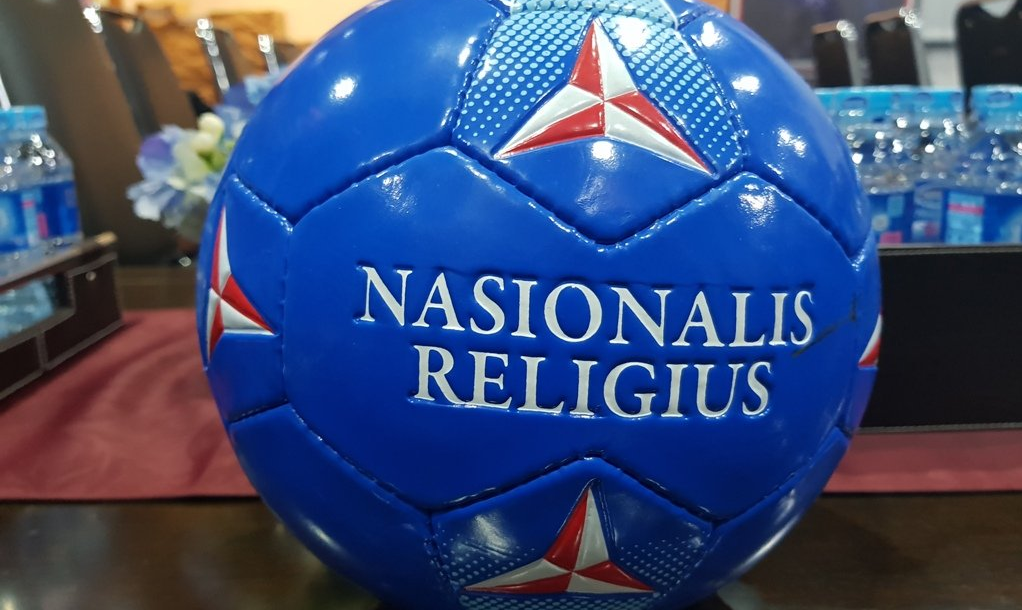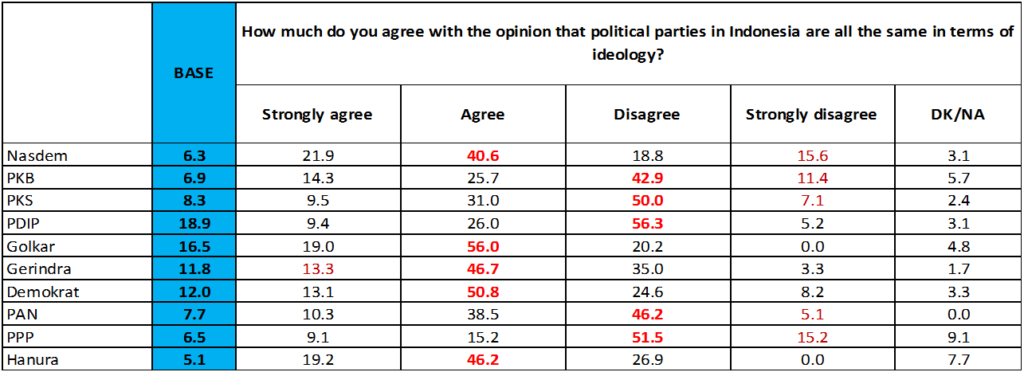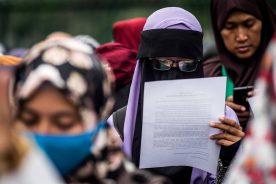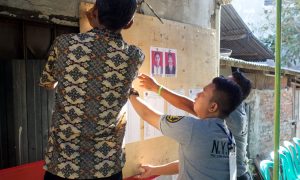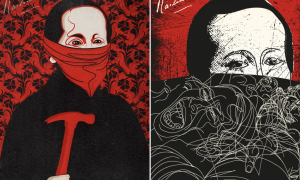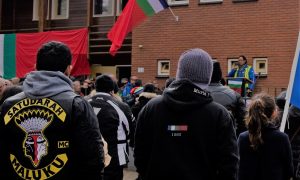Are Indonesia’s political parties all alike? Are some more in favour of political reform than others? Do some favour business interests while others see themselves as siding with the poor? And does it make sense to think of some parties as left-wing and others as right-wing?
Over the twenty years of Indonesian democracy, the answer to such questions has generally been “no”. Many observers have suggested that Indonesian parties differ little on matters of policy and ideology, with the only obvious division between them being the degree to which they believe Islam should play a role in public affairs.
Scholars have reached this conclusion largely by looking at how parties behave and interact with one another, often remarking that even the ideological cleavage between Islamic and non-Islamic parties is not associated with programmatic differences in key areas such as fiscal and social policy. Political scientists such as Dan Slater and Kuskridho Ambardi have argued that Indonesian politics are dominated by a “cartel” of parties characterised by their common desire to share the spoils of office, rather than by ideological or policy differentiation. As a result, parties are willing to form very broad and ideologically heterogeneous “rainbow coalitions” comprising both Islamic and non-Islamic parties.
Another way to explore ideological difference and convergence, however, is to examine how political elites themselves perceive the ideological leanings of their own parties and those with which they compete. While surveys of political elites are common in comparative research, in the Indonesian case we lack comprehensive data on how politicians perceive their parties’ positions on crucial issues. We have therefore been unable to accurately measure where Indonesian parties stand on the various ideological dimensions that might structure politics in the country.
Such perceptions are important. Even if parties are willing to cooperate in order to share power, as the party cartel thesis emphasises, they might still promote different ideological visions and policies once in office. And there are reasons to believe that such visions might vary, not least the fact that some of the parties have very different origins. For example, the Golkar party was the electoral vehicle of the former authoritarian regime of President Suharto, while PAN (the National Mandate Party) was formed by Amien Rais, one of the leaders of the Reformasi movement that led to the demise of that regime. Should we therefore expect that politicians from these two parties will have different outlooks on the post-Reformasi political system?
In order to collect such systematic data on party elites’ views, in late 2017 and early 2018 Lembaga Survei Indonesia (LSI), in a project based on cooperation with the Australian National University (ANU), conducted a survey of 508 randomly selected members of Indonesian provincial legislatures (DPRD). The respondents were chosen from the legislatures of 31 of Indonesia’s 34 provinces (only North Kalimantan, West Papua and West Sulawesi did not make the final cut), in a way that was representative of the entire national population of provincial DPRD members. Our survey covered a large number of issues, including legislators’ attitudes to democracy, their religious views, their family and professional backgrounds, and their thoughts on the major political issues of the day.
We will be analysing this material in detail, and comparing these party elites’ views with the views of the Indonesian population as a whole, in later publications. In this post, we simply want to highlight what the survey tells us about party diversity in Indonesia, and offer some thoughts on how the findings contribute to the ongoing debate about the structure and representativeness of Indonesia’s contemporary party system.
The survey results
To measure party ideology, we asked respondents to locate their own parties’ positions on nine key ideological questions using a series of ten-point scales. We then averaged the numbers given by each party’s respondents in order to locate that party on an ideological spectrum with relation to the issue concerned. (For example, to ascertain whether parties were differentiated by their attitudes to economic policy, we asked each respondent: “If measured on a scale of 1 to 10, where 1 means ‘a party that promotes economic equality’ and 10 means ‘a party that promotes economic growth’, where would you place your own political party?”)
On many questions we found parties were clustered closely together, mostly around the centre of the spectrum—sometimes toward the “right”, other times toward the “left”.
Confirming a common assumption in the literature, however, there was only one issue area that produced clear and consistent ideological differentiation: religion. In our two questions that dealt with the role of religion in politics, respondents answered in ways that spread the parties relatively widely along the spectrum of possible scores.
We asked respondents about the degree to which their party was based on Pancasila—the official state ideology, which implies the adoption of a pluralist position—which was scored at 1, or on Islam, which was scored at 10. By this measure, the most Islamic party in the view of its own members is PPP (the Unity Development Party), with an average score of 7.22, while the most Pancasila-oriented is PDI-P, at 1.82.
This constitutes a significant gap of 5.4 separating the positions of these two flank parties. Remove these two outliers and the gap between the most distant parties is still considerable, at 3.4. The average position of all parties (at 3.27) is tilted toward Pancasila rather than Islam.
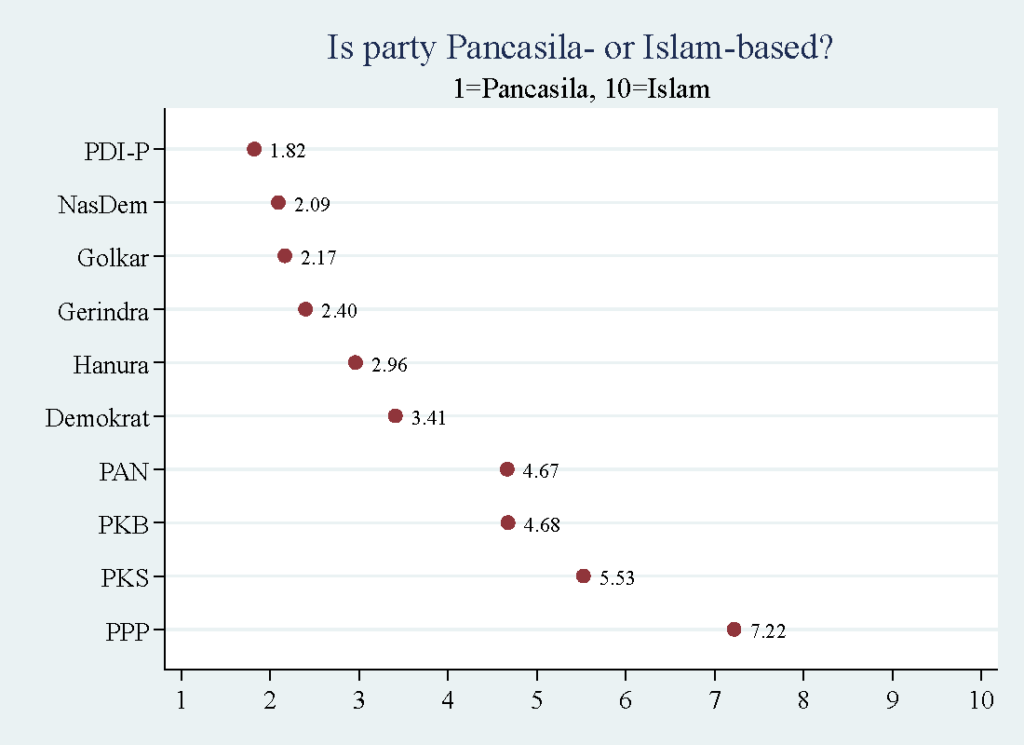
Another question on religion qualifies this result, while also producing a notable if less dramatic spread. We asked respondents whether they saw their own party as seeking a smaller (1) or larger (10) role for Islam in politics. Here answers were tilted significantly to the right, with only two parties scoring below 5 (see table below). These results suggest that on average, Indonesian provincial politicians see their parties as wishing Islam to play a more prominent role in politics. Even so, there is significant variation among parties on this issue, with 3.79 points separating the lowest-scoring party (again, PDI-P) and the highest-scoring party (again, PPP).
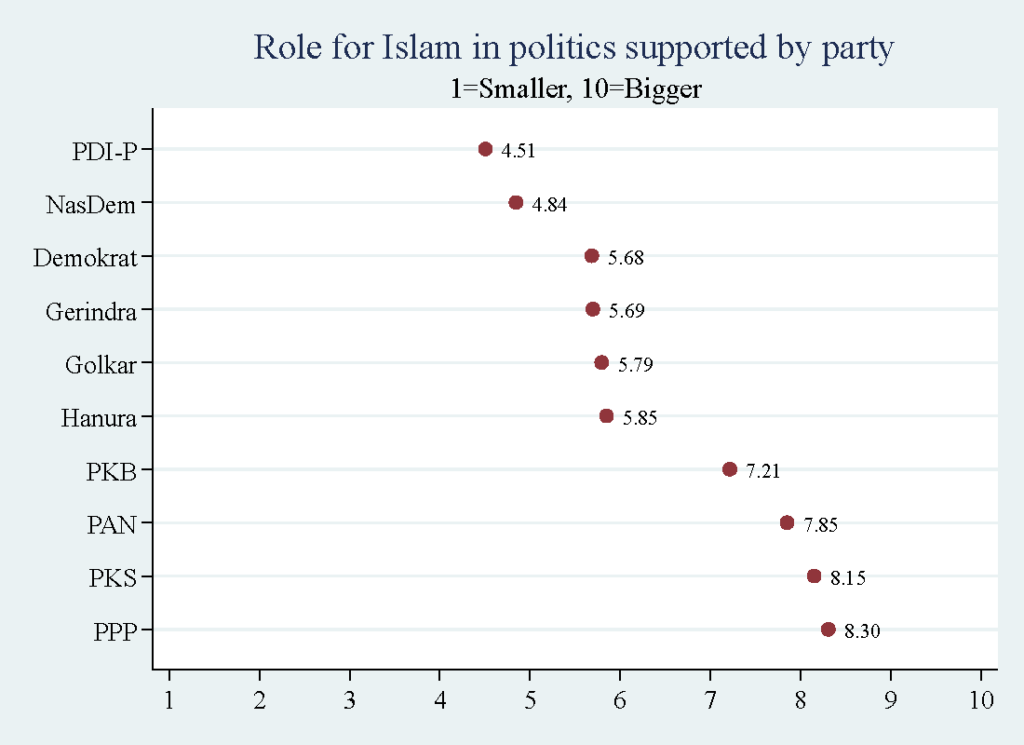
On whether they desire a greater or lesser political role for Islam, the four Islamic-based parties are in one group toward the right of the spectrum. PDI-P and Nasdem are the only two parties whose members agreed, on average, that they wanted a somewhat lesser role for Islam, while the other four parties are clustered closely together just to the right of centre. In the previous scale on Pancasila vs. Islam, the spread was substantially wider.
It is worth pointing out that even though there is clear differentiation among parties on the role of religion in politics, the parties overall are not strongly polarised on this issue; i.e. we do not see clustering of parties at opposite ends of the spectrum. Taken together, the results suggest that many of the provincial DPRD members we interviewed do not see Pancasila as necessarily implying a commitment to the implementation of secularist policies.
A pluralist–Islamic divide could also be observed when we asked politicians the more general question of whether they agreed that “all Indonesian political parties have a similar ideology”. On average, members of the Islamic parties (PPP, PKS, PAN and PKB) and of PDI-P—which is viewed by its members as offering the most pluralist alternative—disagreed with the statement. Golkar and those parties set up by former Golkar elites (Nasdem, Gerindra, and Hanura), together with former President Yudhoyono’s Partai Demokrat, agreed on average that Indonesian parties are similar ideologically (click to enlarge the table below).
What about other issues that might structure party competition? In many countries, especially in Europe, North and South America and Australasia, party leaders and members readily locate their parties on a left–right spectrum. Definitions of “left” and “right” can and do vary, but for the purposes of survey research we can understand a leftist ideological stance as one favouring a significant role for the state in the economy, economic redistribution through social spending, and progressive social policies supporting the rights of women and minorities. Similarly, we can define a right wing party as one that supports market-oriented economic policies, opposes expensive social policy programs to alleviate economic inequalities, and endorses conservative positions on social issues in defence of traditional values.
A language of left–right cleavage is rarely used in daily political discourse in Indonesia, in part because the idea of explicitly left-wing politics was anathematised by the Suharto regime after the 1965–66 massacre of supporters of the Indonesian Communist Party. Even so, we thought it was worth checking whether party elites viewed their parties in this way. We asked whether politicians saw their party as having a “left” or “liberal/progressive” orientation (1) versus a “right” or “conservative” orientation (10). The result? Indonesian parties mostly view themselves as being right-of-centre—but more to the centre than toward the flank.
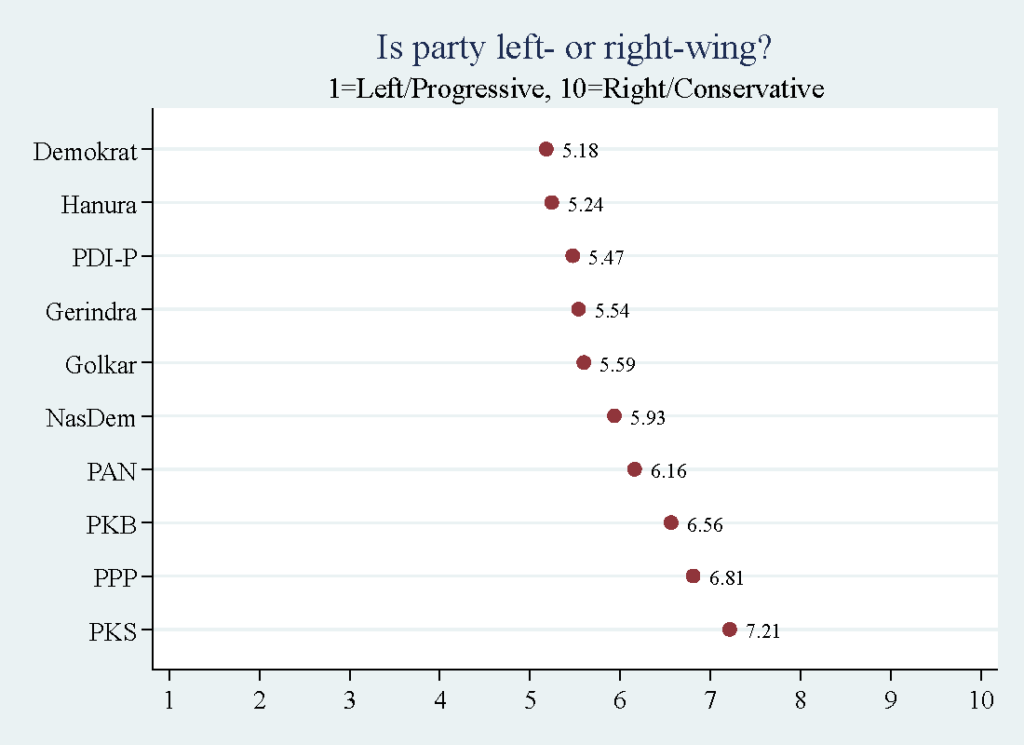
To avoid terminological confusion, before respondents got to this item in the questionnaire we asked them a series of questions that we thought might act as proxies for either a left or right bias. For example, we asked if they saw their party as favouring renewal (pembaruan, scored at 1) or as “maintaining tradition” (mempertahankan tradisi, scored at 10). There was significant spread here, but all parties were on average more in favour of renewal (2.71) than tradition, ranging from Golkar (2.18) to PPP (4.55).
We also asked politicians whether their parties favoured women’s emancipation (1) or believed women should act in accordance with their traditional role (kodrat, 10). Here parties mostly claimed to be emancipatory, with a range from 2.66 (Nasdem) to 5.12 (PPP).
Do politicians believe their parties champion the ideals of the Reformasi movement (1), or do they want to go back to the system used by the New Order (the former Suharto regime) (10)? They all say they support Reformasi, with an average score of 1.98. Notably, on this question the views of politicians from Golkar and its offshoots, such as Gerindra and Hanura, are not dramatically different to those of parties most associated with the Reformasi movement, particularly PAN and PDI-P.
When it comes to the economy, most parties turned out to have statist inclinations. We asked whether they favoured a greater role for the state (1) or private sector (10) in the economy, and averages ranged from Gerindra with 3.05, to PKS with 4.88. When asked whether their parties favoured the interests of the poor (1) or of investors (10), respondents all claimed their parties favour the poor, with party averages clustered tightly between 2.09 (PKB) and 3.34 (Golkar).
Recall the question we mentioned earlier, about a party’s prioritising economic equality (1) or economic growth (10). It turns out that the most pro-equality party was the PKB (National Awakening Party) with a score of 4.26, while the most pro-growth party was the Hanura Party (People’s Conscience Party) with a score of 5.58 (just over the middle of the scale, which is 5.5). With such little variation along the scale (4.26 to 5.58), and an average overall score among parties of 4.99, we can conclude that all Indonesian parties feel they must strike a balance between economic egalitarianism and growth.
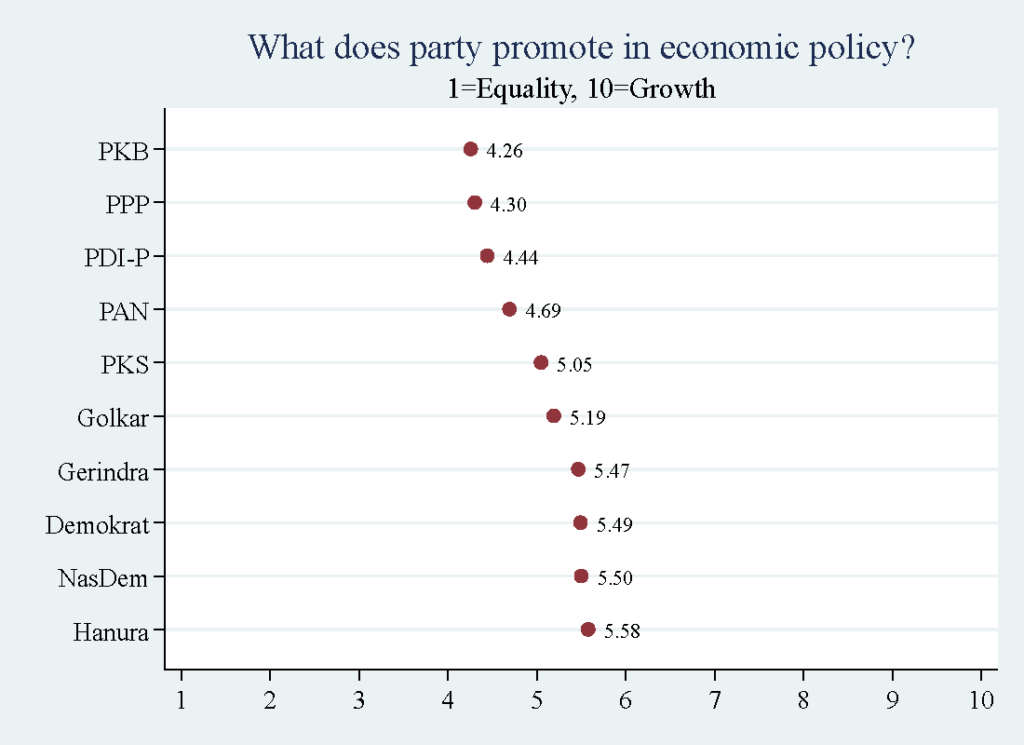
Heterogeneous public, homogeneous parties?
A few patterns are visible in our data: PDI-P tends to be located toward the left on most issues, while PPP is at the far right, at least on questions with a social or religious character.
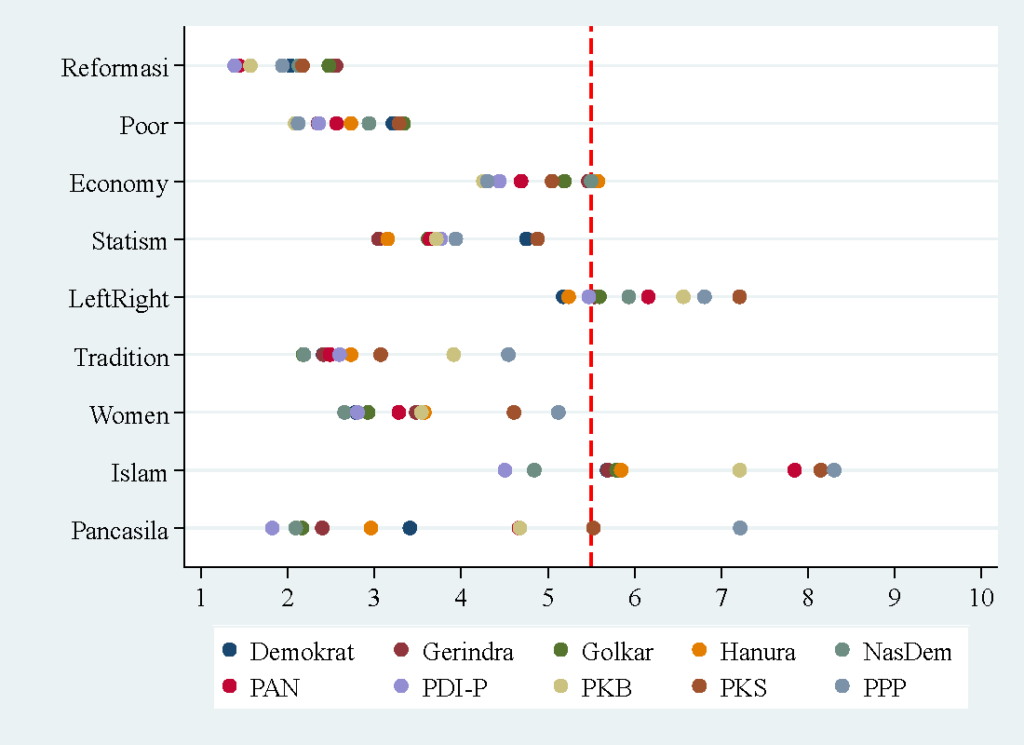
Overall, though, our findings provide a consistent picture of ideological convergence amongst Indonesia’s political parties across a range of issue areas—with the notable exception of religion. Even where differences on the scale were small, politicians ordered their parties in such a way that reflected a key assumption in the literature on Indonesian politics: that parties differentiate primarily—if not solely—in terms of how they view the role of Islam in public and political life.
Distinguishing piety and fundamentalism in Indonesian Muslims
Survey data show no evidence of a link between piety and intolerance, let alone violence.
 Facebook
Facebook  Twitter
Twitter  Soundcloud
Soundcloud  Youtube
Youtube  Rss
Rss 